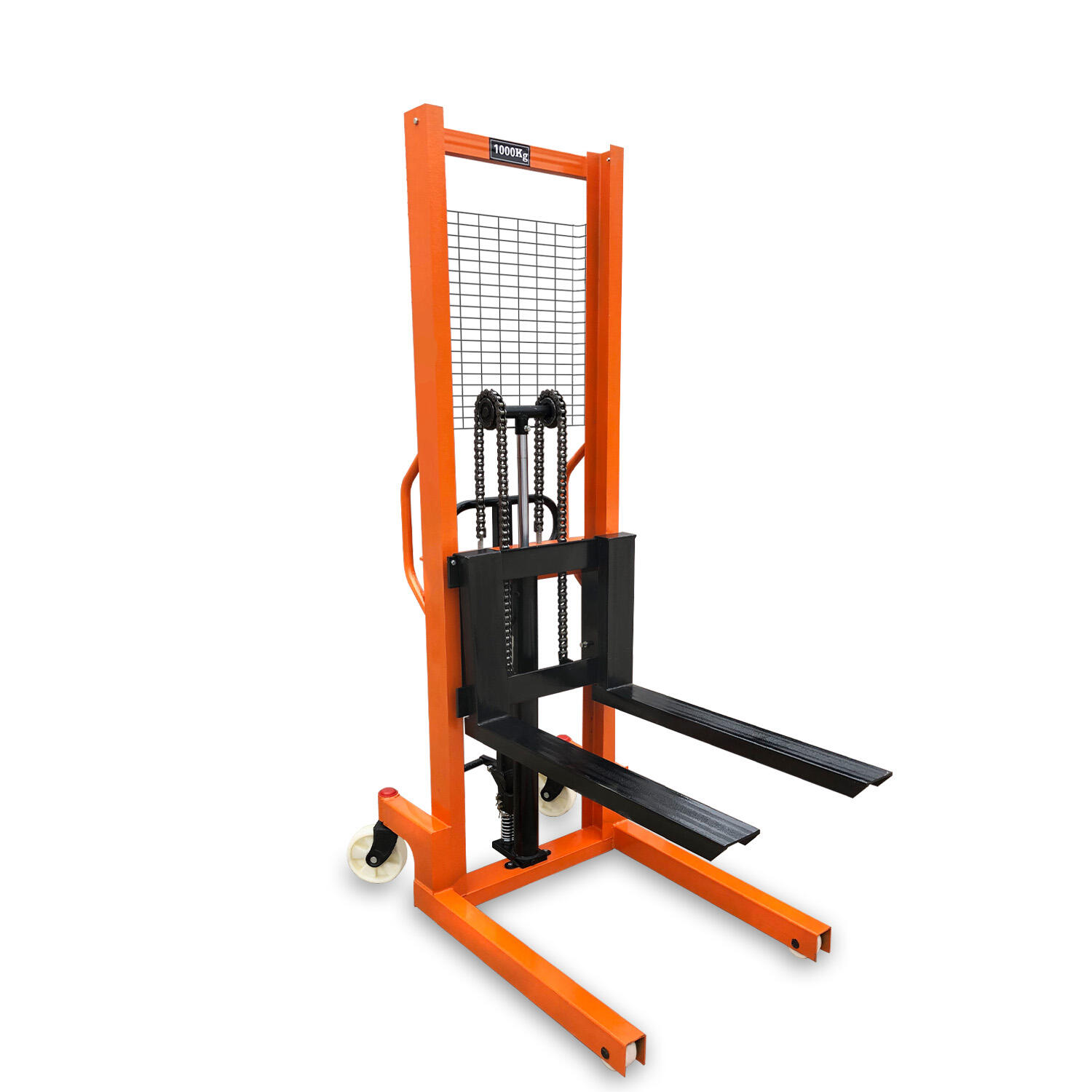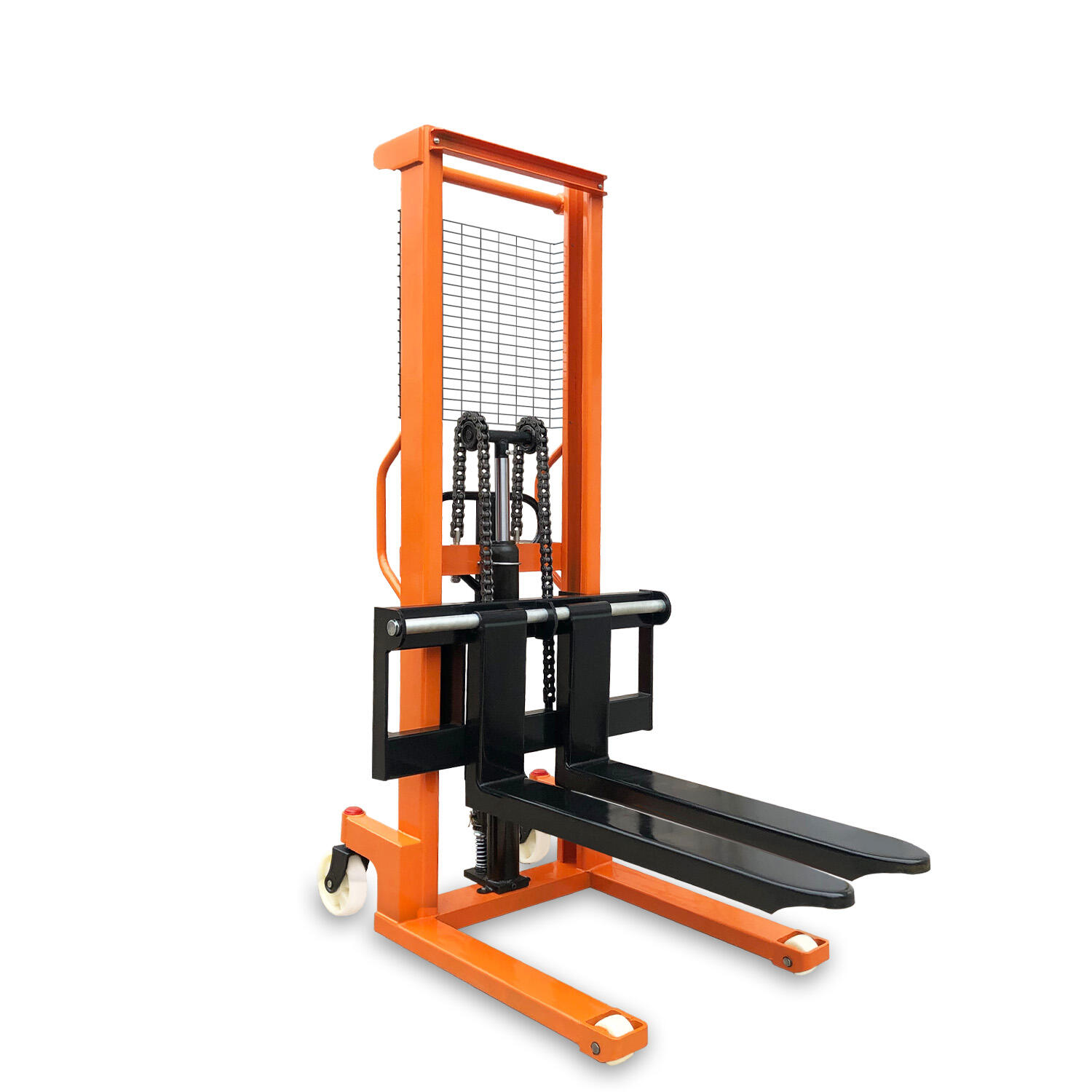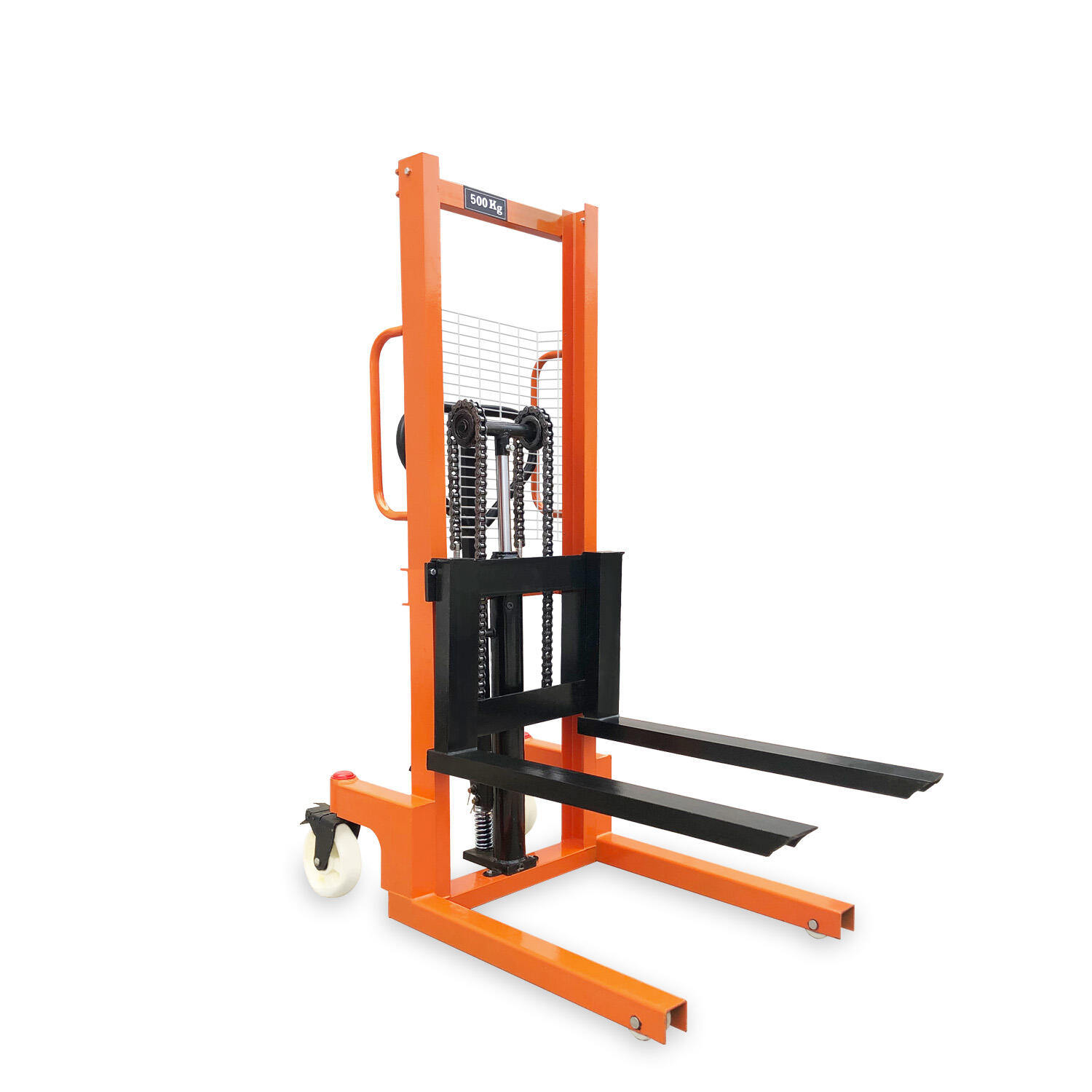משאית פורקליפט ידנית, הידועה גם בשם משאית פורקליפט ידנית או משאית פאלט, היא מכשיר טיפול בסיסי בחומרים שנועד להרים ולהעביר מטענים ממוזגים למרחקים קצרים במחסן, מפעלים, חנויות קמעונאיות ומרכזי לוגיסטיקה. בניגוד למעליות מופעלות, אשר מסתמכות על חשמל או דלק, היא פועלת לחלוטין באמצעות מאמץ ידני, מה שהופך אותה לפתרון בעלת עלות יעילה, בעל תחזוקה נמוכה לעסקים עם צרכים נמוכים עד בינוניים להרים. עיצובו הפשוט, קלות השימוש וגודלו הקומפקטי הופכים אותו למוצר חיוני לפעולות שבהן המרחב מוגבל והכמות של משימות טיפול בחומרים אינה מצדיקה את ההוצאות של מנוע מרים. אחד המאפיינים העיקריים של משאית הרכבה ידנית הוא מנגנון הרימתה, המאפשר לה להרים את המשאיות בדיוק מספיק כדי לנקות את הקרקע עבור תחבורה קלה. הרמת הרמות מתבצעת באמצעות מערכת הידרוליקה המורכבת ממשאבת יד, צילינדר הידרוליק ונוזל הידרוליק. כאשר המפעיל מפום את הידית, הנוזל ההידרולי מכריח לתוך הצילינדר, גורם לפוסטון להרחיב ולרים את המזלגות. עיצוב זה מאפשר למפעיל להרים מטענים שוקלים עד כמה טונות עם מאמץ פיזי מינימלי, הרבה יותר ממה שניתן להשיג עם הרמת יד בלבד. גובה ההרים מוגבל בדרך כלל לכמה אינץ', מספיק כדי לשחרר את המשטח מהקרקע ולהפחית חיכוך במהלך התנועה, אשר מספיק לטיפול במשקל על פני משטח שטוח. המזלגות של משאית מרים ידנית נועדו להתאים גדלים סטנדרטיים של חפיסות, עם אורך טיפוסי של 1150mm ל-1200mm ורוחב שניתן להתאים על דגמים מסוימים כדי להתאים מימדי חפיסות שונים. המזלגות עשויות מפלדה חזקה מאוד כדי לעמוד במשקל של עומסים כבדים ולתמודד עם כופף או עיוות עם הזמן. הם מותקנים על מסגרת המספקת יציבות ותמיכה, להבטיח שהמשאית נשארת בטוחה במהלך התחבורה. המסגרת גם בנויה מפלדה, שנבחרה בשל עמידותה וחוזקתה, עם דגמים רבים עם סיום מצופה באבקה כדי להגן מפני חלודה וקרוסיה, משתרעת את חיי הציוד בסביבות קשות. היכולת לתמרון היא יתרון בולט של משאית הרכבה הידנית, הודות לגודל הקומפקטי שלה ועיצוב קל. הוא קטן משמעותית יותר ממעליות מנועיות, ומאפשר לו לנווט דרך מסלולים צר, סביב מכשולים, ולחזרים צרים כגון אחוריות של משאיות משלוח או חדרי אחסון קטנים. זה הופך אותו לאידיאלי לשימוש בחנויות קמעונאיות, מחסנים קטנים וסביבות אחרות שבהן שטח הוא בפרמיה. המשאית מצוידת בשני גלגלים גדולים, נושאים מטען מאחור ושני גלגלים קטנים, מסתובבים מקדימה, המאפשרים כוננות קלה ופיתולים צמודים. הגלגלים עשויים בדרך כלל מפוליורטן או גומי, המספקים כוח המשיכה טוב על בטון, אספלט ושטח אחר תוך שמירה על הרעש והנזק לרצפה. הידית של משאית פורקליפט ידנית תוכננה ארגונומית כדי להקל על הפעלה קלה. הוא ממוקם בגובה נוח, ומאפשר למפעיל לדחוף, למשוך ולדחוף את הידית מבלי לכופף או להתכופף, ומפחית את הסיכון לתיקון גב ועייפות. לעיתים קרובות יש למעיק תפוס קל להחזיק, אפילו בעת שימוש ממושך, ואולי כולל ידית שחרור המאפשרת למפעיל להוריד את המזלגות על ידי שחרור לחץ הידרולי. הידית הזאת ממוקמת בדרך כלל ליד הידית כדי גישה מהירה וקל, להבטיח שהפעיל יכול להוריד את המשא בבטחה ובדוקיות כאשר מגיע למיקום הרצוי. קיבולת העומס היא מפרט חשוב של משאית פורקליפט ידנית, עם רוב הדגמים המסוגלים להתמודד עם עומסים הנעים מ 1 טון ל 5 טון. קיבולת המדויקת תלויה בעיצוב ובבניית המשאית, עם דגמים כבדים יותר עם מסגרות מחוזקות ומסמכי פלדה עבים יותר כדי לתמוך במשאבים גדולים יותר. חשוב מאוד שהפעילים יצייתו ליכולת המשא המפורטת כדי למנוע נזק מבני למשאית ולהימנע מפתעות. עומס יתר עלול לגרום לפורקים להתכופף, למסגרת להתכופף, או למערכת ההידרוליקה להיכשל, כל אלה מהווים סיכונים משמעותיים לביטחון. תכונות בטיחות משולבות בעיצוב של משאית הרכבה ידנית כדי להבטיח תפעול בטוח. בנוסף לגבולות קיבולת המשא, מודלים רבים כוללים שסתום אבטחה לחץ יתר שמונע מהמערכת ההידרוליקה להרים עומסים העולים על קיבולת המונה, ומספקת שכבה נוספת של הגנה. בסיס רחב של המשאית ומרכז הכובד נמוך משפרים את היציבות, מקלילים את הסיכון להתפופף במהלך התחבורה, אפילו כאשר ניווט על משטחים לא רמוכים. הגלגלים המסתובבים בחזית מצוידים לעתים קרובות בלמים שניתן להפעיל כדי לשמור על המשאית עצומה בעת הטעינה או ההורדה, ומונעים תנועה לא מכוונת. בנוסף, מנגנון ההורדה האיטי והמושלט מבטיח כי המטען לעולם לא יורד פתאום, ומפחית את הסיכון של נזק לסחורה או פציעה של עובדים. יישומי משאית הרכבה ידנית מגוונים ונפוצים בתעשיות שונות. במכירת הקמעונאות, הוא משמש להעברת חבילות של מאגר מחדרי אחסון לרצפות המכירות, לטפל בדברים בגדלים כגון משקאות בבקבוקים או מוצרים ממוזגים, ולטעינה/פרוק משאיות משלוח. בייצור, הוא מסייע בהובלת חומרי גלם לקווי הייצור, העברת פריטים בתהליך עבודה בין תחנות, ואחסון מוצרים גמורים. מחסנים ומרכזי הפצה מסתמכים עליו לארגן חפיסות, להקל על איסוף הזמנות, ולהעביר סחורות למעונות המשלוחים וממקומותיהם. הוא שימושי גם באולפנים, במוסכים ובחנויות תיקון מכוניות כדי להרים מנועים, צמיגים וחלקים כבדים אחרים. אפילו בסביבות מגורים, כמו מתקני אחסון עצמיים, משאית הרכבים ידנית מסייעת ללקוחות להזיז ולהציב חפצים כבדים. תחזוקה של משאית פורקליפט ידנית היא פשוטה יחסית, הודות לעיצוב הפשוט שלה עם מעט חלקים נעים. משימות תחזוקה שגרתיות כוללות בדיקת רמת הנוזל ההידרולי והבטחה שאין דליפות במערכת ההידרוליקה. נוזל צריך להיות מחולל במרווחים קבועים כדי למנוע זיהום, אשר יכול לפגוע במשאבה ובצילינדר. גלגלים וגלגלים צריכים להיות בודקים על גמישה, ולוחים כדי להבטיח תנועה חלקה. צריך לבדוק אם המזלגות והמסגרת מופיעות בסימנים של נזק, כגון סדקים או כפפות, וכל בעיה צריכה להיפתר במהירות כדי למנוע הידרדרות נוספת. מנגנון הידית והפמפ צריך להיות גם משומן באופן תקופתי כדי להבטיח שהם פועלים בצורה חלקה. עם תחזוקה נכונה, משאית פורקליפט ידנית יכולה לספק שירות אמין במשך שנים רבות, מה שהופך אותה להשקעה חסרת עלות. בעת בחירת משאית פורקליפט ידנית, חברות צריכות לשקול מספר גורמים כדי להבטיח שהיא עומדת בצרכים הספציפיים שלהן. יכולת העומס היא שיקול עיקרי, שכן היא חייבת להתאים למשקל המקסימלי של העומסים שיש לטפל בהם. אורך ורוחב המזלגות צריכים להיות תואמים עם הסללים המשמשים בפעולה, עם מזלגות קבועות המציעות גמישות רבה יותר. סביבת ההפעלה חשובה גם כן; לדוגמה, משאיות המשמשות במתקני אחסון קרים עשויות לדרוש חומרי סיכה מיוחדים כדי לעמוד בטמפרטורות נמוכות, בעוד שאלו המשמשות בחוץ עשויות לדרוש תכונות עמידות למזג אוויר. גודל המשאיות כולו צריך להיחשב ביחס למרחב הזמין, כאשר דגמים קומפקטיים מתאימים יותר למסלולים צר. המחיר הוא גורם, אבל הוא צריך להיות מאוזן עם איכות, כמו משאית עמיד, בנוי היטב יציע ערך טוב יותר בטווח הארוך מאשר זול יותר, חלופה פחות אמין. לסיכום, משאית פורקליפט ידנית היא כלי רב-שפע וחיוני לעסקים שזקוקים להעברת מטען ממוסמר ביעילות ובבטיחות. שילוב הפעולה הידנית, הכוח ההידרולי, עמידות, ונימוס הופך אותו לפתרון בעלות יעילה למגוון רחב של משימות טיפול בחומרים. בין אם משתמשים בו בחנות קמעונאית, במחסן, במפעל ייצור או באולפן, הוא מקל על העבודה הימנית, מקטין את הסיכון לפציעות ומשפר את יעילות הפעולה. על ידי השקעה במשאית פורקליפט ידנית באיכות גבוהה ותחזוקה נכונה, עסקים יכולים לשדרג את תהליכי טיפול החומרים שלהם ולהשיג רווחים ברוב המשאבים לטווח ארוך.


